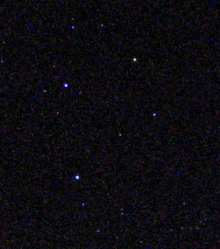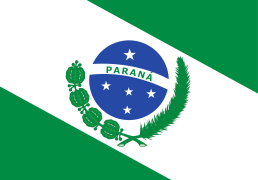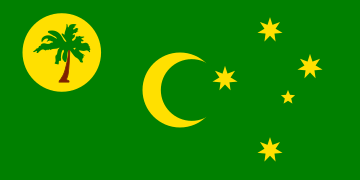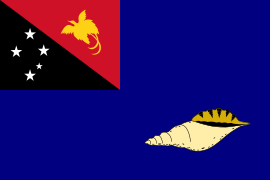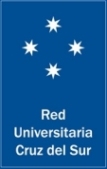Crux
Crux is a constellation of the southern celestial hemisphere, composed of two crossed segments, one 4.2 and the other 5.4 degrees long, occupying an area of only sixty-eight square degrees, therefore which covers barely 1/600 of the sky. It is the smallest of the eighty-eight constellations that make up the celestial vault, according to the limits set in 1930 by the International Astronomical Union (UAI).
It is useful for orientation, since it allows us to determine the southern cardinal point: by prolonging the main axis of the cross four and a half times in a straight line, starting from its brightest star, Ácrux, the foot of the cross, we reach to the south celestial pole, the point around which the celestial vault apparently rotates. Once this extension is done, it is enough to go down a vertical towards the horizon line and the geographic south is found there with enough precision. Although due to its proximity to the south celestial pole, Crux revolves around it visibly during the course of the night, its position does not matter for this location procedure, since its largest arm, when rotating around the celestial pole, always determines its place.
It borders on three of its sides with the constellation of Centaurus, while to the south it does with that of Musca. The ancient Greeks considered it to be part of Centaurus, but it was defined as an independent star pattern in the 16th century, after Amerigo Vespucci's expedition to South America in 1501. Vespucci mapped both the two stars Alpha Centauri and Beta Centauri as well as the Crux stars.
Although the ancient Greeks knew of these stars, gradual precession brought them below the European horizon before the Christian era, so they were forgotten. It is probable that towards the year 5000 a. C., at the end of the last ice age, Centaurus and Crux were visible above the horizon at midnight in spring in central European latitudes. The cross that it resembles is of the Roman type with one crossbar longer than the other. Approximately 2,000 years ago, at the time of the birth of Jesus of Nazareth, who would be associated with the sign of the Roman cross, it was visible from the latitude of Jerusalem, Mesopotamia, and Persia (in the south of the territory occupied by the Roman Empire). childbirth) erected on the horizon at midnight on February days, so that it could be the "Star of the Child" or "Sign of Jesus" that the "Magi from the East" saw from their country of origin, and later in his journey from Jerusalem to Bethlehem, which is six miles to the south. This can be verified in a planetary simulator like Stellarium. At present the constellation is visible south of 25° north latitude, and all its stars are circumpolar south of 35° south latitude.
Notable features
Crux's brightest star is β Crucis, called Mimosa. It is a blue subgiant of spectral type B0.5V located about 280 light-years away. It has a close companion whose orbital period is 5 years, completing the system with a third component, a main presequence star still in the process of formation. Ácrux (α Crucis) is the second brightest star in the constellation. It is a stellar system whose two main components, Alpha-1 Crucis and Alpha-2 Crucis, are a subgiant of type B0.5V and a main sequence star of type B1V; Alpha-1 Crucis is, in turn, a spectroscopic binary with a period of 75.86 days.
Numerous stars in the constellation are members of the Lower Centaurus-Crux subgroup, within the Scorpius-Centaurus Stellar Association, the closest OB stellar association to the Solar System. In addition to Mimosa, δ Crucis (Imai), ζ Crucis, λ Crucis and μ Crucis are part of it.
In contrast, γ Crucis (Gacrux), Crux's third brightest star, is a red giant of type M3.5III and 3400 K in temperature. It has a large size, its diameter being 113 times larger than the Sun. It is thought that it may be accompanied by a white dwarf (it is considered a "mild" barium star), but the existence of such a companion has not yet been confirmed. Distant 88 light-years, it is the closest red giant to Earth.
In Crux are located several massive and luminous stars. CD Crucis is a binary system composed of a hot blue star of type O5V and a Wolf-Rayet star of type WN6; Furthermore, it is an eclipsing binary with an orbital period of 6.24 days. The blue star is 57 times more massive than the Sun, and its companion has a mass of 48 solar masses. DI Crucis is also a Wolf-Rayet star, type WN3pe, with an effective temperature of about 90,000 K and 500,000 times more luminous than the Sun. It is a known source of X-rays and is part of the distant Association stellar Cru OB4, O-type association distant 4000 parsecs.
Even further away —at about 6,500 parsecs—, Hen 3-759 is a blue supergiant of type O8Iaf and 30,500 K in temperature: it is thought that although it initially had a mass of 60 solar masses, the high rate of loss of stellar mass has reduced it to about 40 solar masses.
Among the deep space objects in the constellation is NGC 4755, an open cluster known as "The Jewel Box," which contains about a hundred stars. At an age of 16 million years, it is one of the youngest known clusters. It is located approximately 1,700 parsecs from the solar system.
The Coalsack Nebula is a prominent dark nebula visible to the naked eye as a dark patch obscuring a small section of the Milky Way. Lying at a distance of approximately 150 parsecs, it is characterized by complex filamentous molecular structures containing many dark nuclei. Its total mass is estimated to be about 3,500 solar masses.
Main Stars
- α Crucis (Ácrux), the brightest of the constellation with magnitude 0.87 and the most luminous twelfth of the sky, is a white-blue star.
- β Crucis (Mimosa), subgigante blue and magnitude 1.25. It's a Beta Cephei variable.
- γ Crucis (Gacrux), large red giant and magnitude 1.59. It is thought to be accompanied by a white dwarf whose existence has not yet been confirmed.
- δ Crucis (Imai), of magnitude 2,79, subgigante blue and variable star Beta Cephei.
- ε Crucis (Ginan), of magnitude 3.56, an orange giant.
- Cruises, a white-azulada star of magnitude 4.04.
- Cristian Crucis, star of magnitude 4,14 at the southern end of the constellation.
- θ Crucis, name of Bayer that share two different stars, θ1 Crucis and θ2 Crucis; the first of them is a spectroscopic binary and a star with metal lines.
- λ Crucis, variable Beta Cephei of magnitude 4,60.
- μ Crucis, double star with 35 seconds of arc separation between components, of magnitudes 4.0 and 5.1.
- R Crucis and S Crucis, cefeidas of mean magnitude 6,90 and 6,73 respectively.
- BZ Crucis, variable star Gamma Cassiopeiae of magnitude 5.32.
- CD Crucis, massive binary composed of a hot blue star and a star of Wolf-Rayet.
- DI Crucis (WR 46), also a star of Wolf-Rayet, variable between magnitude 10.62 and 10.94.
- HR 4908 (HD 112244), massive blue supergiant 525 000 times brighter than the Sun.
- HD 108147, yellow star with an extrasolar planet.
- TYC 8997-1597-1, binary system composed of a pulp (PSR B1259-63) and a Be Star (SS 2883).
- Hen 3-759 (TYC 8978-4440-1), massive blue supergiant that appears not to be associated with any cluster or association OB.
Deep Sky Objects
- Open star cluster "El Joyero" (NGC 4755), with stars of several contrasted colors. The main star is κ Crucis, a red supergiant of type M of visual magnitude 5.98.
- The Sacred Nebula of Coal (Coalsack In English), one of the darkest and dense nebulae. It was observed by the Spanish navigator and conqueror Vicente Yáñez Pinzón in 1499.
- The Dragon Fish Nebula, which contains which can be the largest and most brilliant star association in our galaxy.
- The open star cluster NGC 4609 (also called Collinder 263 or Caldwell 98), which can be seen very close to the variable star BZ Crucis, and which is immersed in the Saco Nebula of Carbon.
Meaning of the Southern Cross in the cultures of the southern hemisphere
In the Inca worldview
In the Tahuantinsuyo, this constellation was of paramount importance for the civilizations that developed in this territory, since the chacana (Andean representation of Crux, in the shape of a cross stepped), which in classical Quechua means something like 'stairway up and down' or 'bridge up and down', symbolically linked the Kay Pacha ('earthly world') with the Hanan Pacha ('world of the gods') and the Uku Pacha ('world of the dead').
Its importance lies in the fact that it is the tangible version of the god Huiracocha, the creator and orderer of the world.
It served as inspiration for the Inca emperor Pachacútec to divide the nascent Inca Empire into four, where each star represents the following:
- γ Crucis represents the Chinchaysuyo to the north.
- β Crucis represents the Contisuyo to the west.
- δ Crucis represents Antisuyo to the east.
- α Crucis represents the Collasuyo to the south.
- ε Crucis represents the imperial capital, the city of Cusco, to the center.
In other Amerindian cultures
Several indigenous cultures of South America considered this constellation as a symbol associated with the rhea.
Located in the Southern Cone of South America, the Mapuches, who call it Melipal ('Four stars') in Mapudungun, considered it a representation of the footprint of a choyke, the rhea or American ostrich, a sacred animal in their beliefs.
In northern Patagonia, around the 16th and 17th centuries, it was imagined that the Milky Way was the representation of a rhea hunting field, where the hunters used boleadoras, represented by the pointer (α and β Centauri) while the Magellanic Clouds represented the bodies of hunted animals and The Pleiades, known in the region as "The Seven Little Goats", were the nest of the rhea.
For the Mocovíes, in the Chaco region, the pointer and its nearby stars represented two hunting dogs and the Cruz del Sur, the central body of the stalked rhea, while the remaining stars near the cross completed the figure of the animal.
For the Bororó, in Brazil, the cross was part of a constellation that represented a rhea, the cross itself being one of its two legs.
In other cultures
In Australian Aboriginal astronomy, the Coalsack Nebula and the Southern Cross mark the head of the "emu in the sky" in various Aboriginal cultures. The cross is also considered to represent a possum sitting on a tree and a symbol of the heavenly deity Mirrabooka.
For the Maoris, who call it Te Punga ('the anchor'), it is the representation of the anchor of the waka, or canoe, of Tama -rereti, symbolized by the Milky Way. In addition, the constellation was used in its travels through the Pacific Ocean to locate the south.
In Samoa the constellation is called Sumu ('trigger fish') due to its rhomboid shape.
In Tonga it is called Toloa ('duck'). It symbolizes a duck flying south with one of its wings (δ Crucis) broken by a stone thrown by Ongo tangata ('two men'), represented by α and β Centauri.
In Indonesia and Malaysia, it is known as Buruj Pari ('the manta ray constellation'). Ethnic Javanese call this constellation Gubug pèncèng ('hut ') or lumbung ('barn') due to its shape.
In ancient yiotisha, the cross is called Trishanku.
In vexillology
As a symbol representing the southern hemisphere, the flags of some countries that belong to it—such as Australia, New Zealand, Papua New Guinea, and Samoa—honor it. The Brazilian flag has a constellation in its center where the Southern Cross stands out. Likewise, it is part of the pavilions of the Argentine provinces of Santa Cruz and Tierra del Fuego, Antarctica and the South Atlantic Islands; from the Australian state and territories of Victoria, Northern Territory, Australian Capital Territory, Territory of Cocos (Keeling) Islands and Territory of Christmas Island; from the Brazilian municipality of Cruzeiro do Sul; from the Chilean regions of Coquimbo, Los Lagos and Magallanes y Antártica Chilena; from some Peruvian towns such as Cajabamba and Canoas de Punta Sal; from the Uruguayan department of Colonia; the New Zealand territory of Tokelau, and the Papuan provinces of West New Britain, West New Ireland, and Simbu. It is also represented on the Mercosur flag.
Institutions
Contenido relacionado
(104) Klymene
Canis major
Star catalog





